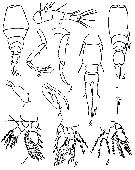
Issued from : S. Krishnaswamy
in Rec. Indian Mus., 1952, 49 (3-4). [p.325, Text-Fig. 2]. As
Corissa indica.
Female (from Madras, India): a, habitus (dorsal); b, abdomen ; c, A1; d, A2; e, Mxp; f, P1; g, P2; h, P4.
Male: j, A2; k, Mxp; l, habitus (dorsal).
Female characters: Cephalosome bearing 2 prominent corneal lenses at the anterior end, these are not widely separated. Optic-cup is deep orange in colour.
5 thoracic segments which decrease in breadth gradually.
Cephalothorax twice as long as the abdomen.
Abdomen 3-segmented.
Genital segment bearing 1 seta on each side.
Caudal rami broad and lamellar, carrying 3 apical setae and 1 sub-apical lateral seta each, on inner and outer margins.
A1 5-segmented, proportional lengths of segments 1 to 5: 11, 18, 19, 10, 15, respectively.
A2 4-segmented; basal segment bearing 1 spine on the innerside, 2nd segment twice as long as the 1st and carries 1 short spine about its middle on the inner side; 3rd segment very small and devoid of spines and setae; terminal segment 6 times longer than the 3rd, carries 2 setae and 1 spine at the apex.
Mxp 2-segmented and the swollen 2nd segment carries 1 stout spine and 1 seta at the apex.
There are 4 pairs of biramous swimming feet. Exopodite as the endopodite 3-segmented.
P5 represented by a single bristle which is long, reaching the end of the genital segment.
Body transparent and colourness.
Male characters: Excepting the genital segment which is of a deep orange colour.
The 2 corneal lenses at the anterior side are very close to each other.
last thoracic segment very narrow and carries 3 bristles on each side which represent the P5.
Abdomen 2-segmented; genital segment very swollen and carries a spinous process on each side at the posterior corners.
Caudal rami longer than broad and provided with 2 setae each at the tip.
A1 as in female.
A2 4-segmented as in female, but differs from that of latter in the absence of a spine on the basal segment, the 2nd segment being setose on the outer sife, the 3rd segmentcarrying a spine on the inner side and the terminal segment has only 1 claw-like spine.
Mandible and Maxillae as in female;
Mxp 2-segmented, prehensile; the 2nd segment which is very stout carries a row of spinules and is hinged to an apical claw which is longer than the rest of the appendage.
Swimming legs similar to those of female.
P5 represented by 2 bristles.
The body is colourness and transperent.





